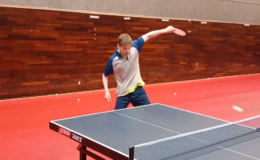By Larry Hodges, USATT Hall of Famer and Certified National Coach
When developing your shots, you want to use a neutral grip; otherwise, your strokes might not develop properly. (This is for shakehanders.) A neutral grip makes proper strokes more natural. You might be tempted to use a slight forehand or backhand grip as you develop your stroking techniques, but in the long run, this will hurt you.
What is a neutral, forehand and backhand grip? If the thinnest part of your wrist lines up with the blade (so the blade and the back of your wrist both aim in the same direction), then you have a neutral grip. If you tilt the top of the blade away from you, you have a backhand grip. If you tilt the top of the racket toward you, you have a forehand grip. (If you aren’t sure what a shakehands grip is, google “table tennis shakehands grip pictures,” and a zillion examples will show up.)
However, a neutral grip is not necessarily the way to maximize your play at the intermediate and advanced levels. It’s a tradeoff. At the higher levels, the strokes are already well developed, and so experimenting with the grip won’t hurt a player’s strokes much.
I used a neutral grip roughly the first decade I played. Then I used a slight backhand grip for roughly a decade. Then I went to a slight forehand grip for roughly the past decade. A backhand grip tends to favor backhand blocking and backhand looping, and gives a natural forehand sidespin loop (so it hooks left for a right-hander). A forehand grip tends to favor backhand hitting and forehand looping, and gives a better inside-out loop on the forehand (so the ball curves to the right for a right-hander).




